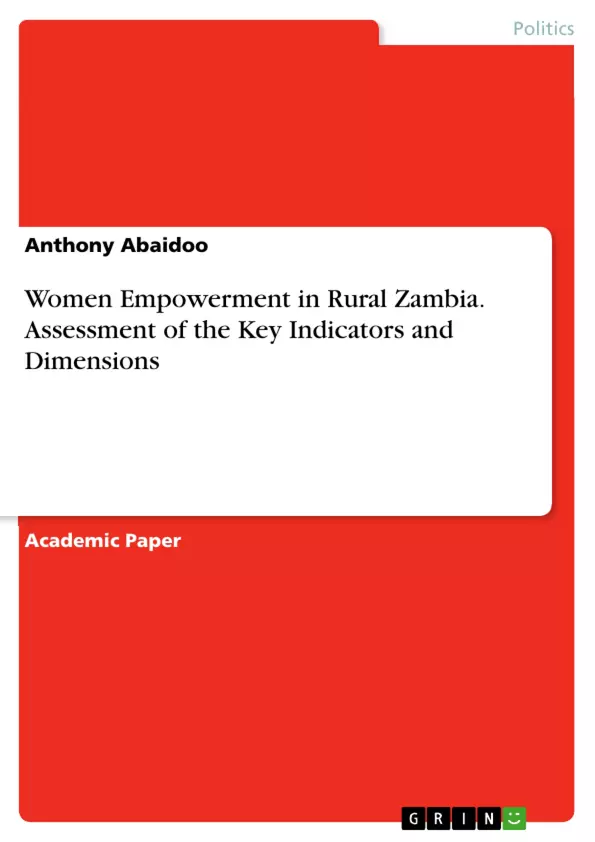Women empowerment remains an important subject of concern to governments and international organizations across the globe. It has been observed that a higher percentage of women within Africa are disempowered. This study was therefore conducted to assess the key indicators and dimensions of women empowerment in rural Zambia. The data used in the study was gathered from the 2018 Zambian Demographic and Health Survey. Following Alkire-Foster multidimensional poverty methodology, women empowerment was measured by using 11 indicators which were grouped into five dimension; agency, income, leadership, resources and workload/time. Data analysis was done by using descriptive statistics and probit and logit models. The findings revealed that 76.23% of rural women take joint decision on their health with their spouse; and 62.81% take join decision with their spouse on large household purchases. Apart from women in Eastern rural Zambia, majority of the women didn’t justify violence in any form. Additionally, 53.0% of rural women do not own a house and 45.42% can’t read at all while 97.34% rely on charcoal and wood and their cooking fuel.
Inhaltsverzeichnis (Table of Contents)
- I. INTRODUCTION
- II. METHODOLOGY
- a) Source of Data
- b) Measurement of Women Empowerment
- i. Women Empowerment
- ii. Measurement
- iii. Alkire-Foster Methodology
- iv. Computation of Women Empowerment Index (WEI)
- v. Explanation of the computation of the five domains
- c) Empirical Model
- III. RESULTS AND DISCUSSION
- a) Descriptive Statistics
Zielsetzung und Themenschwerpunkte (Objectives and Key Themes)
This study examines the key indicators and dimensions of women empowerment in rural Zambia, focusing on the challenges and opportunities faced by women in this context. The objective is to analyze how empowerment is measured and assess the factors that contribute to or hinder women's empowerment.
- Measurement of women empowerment using the Alkire-Foster methodology
- Assessment of the five key domains of women empowerment: Agency, Income, Leadership, Resources, and Time/Workload
- Analysis of the determinants of women empowerment through probit and logit models
- Exploration of the role of decision-making, financial control, and violence in women's empowerment
- Comparison of women's empowerment levels across different regions of rural Zambia
Zusammenfassung der Kapitel (Chapter Summaries)
- I. INTRODUCTION: The introduction sets the stage for the study by highlighting the significance of women empowerment globally and particularly within Sub-Saharan Africa. It presents the context of women's disempowerment, citing statistics on gender disparities in labor force participation, income, and access to resources. The introduction also acknowledges the efforts of organizations like the United Nations to promote women's empowerment and emphasizes the persistent challenges faced by women, especially in rural settings. This chapter lays the groundwork for the study's focus on assessing women's empowerment in rural Zambia.
- II. METHODOLOGY: This chapter delves into the methodological framework of the study. It explains the source of data, the Zambia Demographic and Health Survey (ZDHS), highlighting its purpose and data collection methods. The chapter then provides a comprehensive overview of the measurement of women empowerment, particularly focusing on the Alkire-Foster methodology. The Alkire-Foster methodology involves two steps: identification and aggregation, and the chapter details each step, explaining the key concepts, variables, and calculations involved. It then delves into the computation of the Women Empowerment Index (WEI) and explains the five domains used to measure women's empowerment: Agency, Income, Leadership, Resources, and Time/Workload. This chapter outlines the research design and data analysis techniques employed in the study.
- III. RESULTS AND DISCUSSION: This chapter presents the findings of the study, beginning with a comprehensive analysis of descriptive statistics for the indicators of women empowerment. The chapter focuses on decision-making in healthcare, household purchases, and violence against women, comparing trends across different regions of rural Zambia. It provides insights into the levels of women's empowerment based on the collected data, drawing comparisons to previous studies. The chapter also examines the relationship between various factors and women's empowerment, setting the stage for a deeper analysis of determinants explored in subsequent sections.
Schlüsselwörter (Keywords)
The key terms and focus topics of this study include women empowerment, rural Zambia, Alkire-Foster methodology, multidimensional poverty index, decision-making, financial control, violence, gender parity, and regional disparities. These terms represent the core concepts and areas of research explored in this work, focusing on understanding the dynamics of women empowerment in a rural context.
- Quote paper
- Anthony Abaidoo (Author), 2022, Women Empowerment in Rural Zambia. Assessment of the Key Indicators and Dimensions, Munich, GRIN Verlag, https://www.hausarbeiten.de/document/1327992


